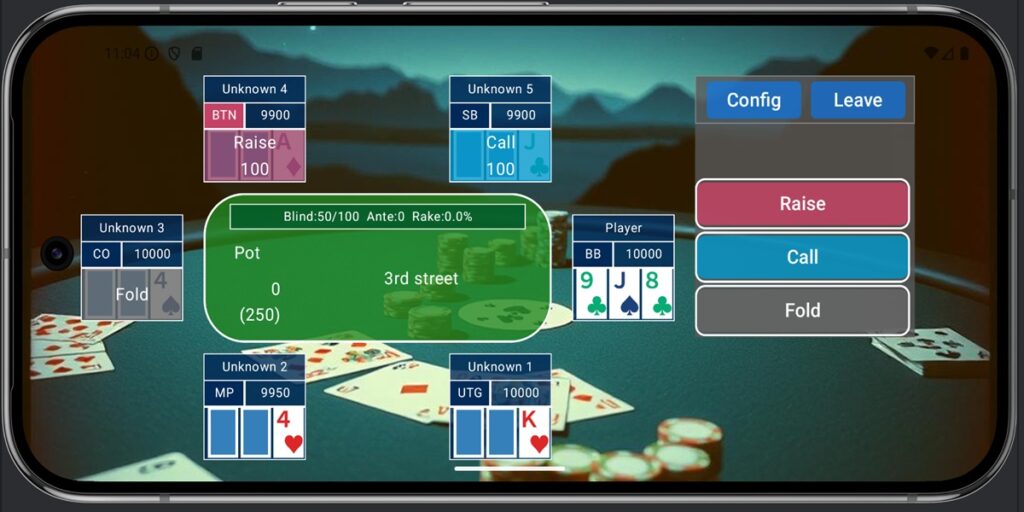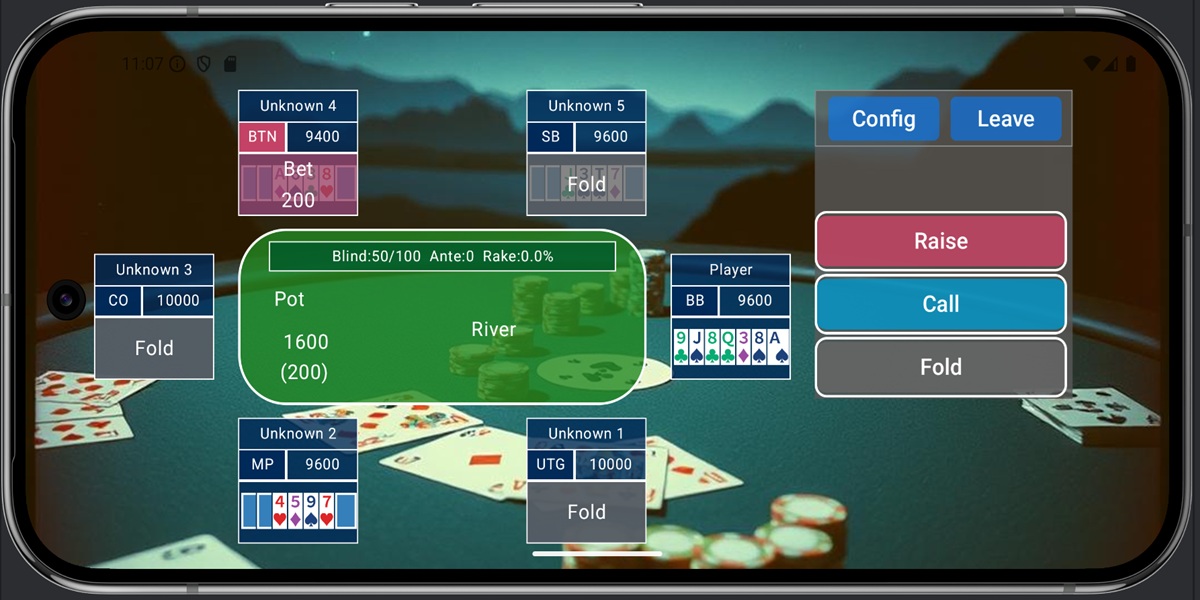Introduction
I’ve been so busy with game development that I haven’t been able to write much lately, but this time I’d like to introduce some screenshots of the game I’m currently developing and briefly explain the rules of a game called Seven Card Stud. Seven-card stud is a poker game that was apparently frequently played before Texas Hold’em became the standard set of rules for poker, and it could be considered a predecessor to Texas Hold’em. Although it doesn’t seem to be played much these days, the game I’m developing does allow you to play it (you can play against NPCs, so you don’t need to gather other players), so I’ll explain the rules.
Basic Rules
The main difference between Seven Card Stud and Texas Hold’em is that the community cards are not shared among all players; instead, each player is dealt their own set of face-up cards. In Seven Card Stud, four community cards are dealt face up, and each player is dealt four face-up cards individually. In addition, the strength of poker hands is compared using the three hole cards dealt to each player plus the seven community cards. The rules for determining and ranking poker hands are the same as in Texas Hold’em. (The image below shows an example of the cards dealt during 3rd Street.)

Three cards are dealt to each player as their hand, and four cards are placed face up in the following order.
- 3rd Street: Deal two face-down cards and one face-up card to each player.
- 4th Street: Deal one face-up card to each player.
- 5th Street: Deal one face-up card to each player.
- 6th Street (Turn): Deal one face-up card to each player.
- 7th Street (River): Deal one face-down card to each player.
Similar to Texas Hold’em, in each round, players decide on their betting action (such as call, raise, or fold). The differences from Texas Hold’em are that the order of actions is determined by a special rule called “Bring In,” and that the amounts of bets and raises are generally fixed (Fixed Limit), with a limit on the number of times they can be made.
The rules for bringing in will be explained later, but first, let’s explain the basic flow of actions. Although it may be confusing, when SB/BB is mentioned below, it refers to the terms Small Bet/Big Bet, not the blinds. In Seven Card Stud, when the stakes are expressed as 100/200, it means Small Bet = 100 and Big Bet = 200. While the Big Blind in Texas Hold’em seems to correspond to the amount of the Small Bet, they are fundamentally different rules.
- 3rd Street: The player with the weakest face-up card, as determined by the bring-in, is forced to bet half the amount of the Small Bet (SB) into the pot. Action begins with the player to the left of the bring-in player. If a player chooses to raise, they can raise to match the Small Bet (called a “Complete”), or raise by the amount of the Small Bet (up to a maximum of 3 times), for a total of up to 4 betting increments. For example, if the SB is 100, the betting progression would be Bring In (50) -> Complete (100) -> Raise (200) -> Raise (300) -> Raise (400). Of course, each player can also Call, and if there are no raises, the round ends at 50. (In reality, it seems that the standard rule is that the bring-in player can immediately choose to Complete, so it might be better to consider the bring-in player as the player who determines the first action.)
- 4th Street: The player with the strongest face-up card determined in the bring-in starts the action. The bet amount is a Small Bet, and there can be a maximum of four raises including the initial bet. If the player with the strongest face-up card has a pair with their face-up cards, they can choose between a Small Bet or a Big Bet for the first bet, and subsequent raises will be at the bet amount initially chosen.
- 5th Street: The player with the strongest face-up card, determined during the bring-in, starts the action. The bet amount is the Big Bet, and there can be a maximum of four raises including the initial bet.
- 6th Street: The player with the strongest face-up card, determined during the bring-in, starts the action. The bet amount is the Big Bet, and there can be a maximum of four raises including the initial bet.
- 7th Street: The player with the strongest face-up card, determined during the bring-in, starts the action. The bet amount is the Big Bet, and there can be a maximum of four raises including the initial bet.
Depending on the rules, the limit on the number of raises may be removed on 7th Street in heads-up situations. If multiple players remain until 7th Street, the winner is determined in a showdown; this is the general procedure for how the game progresses.
Bring In
In Texas Hold’em, the order of players’ actions is determined by their position, but in Seven Card Stud, it is determined by the strength of the face-up cards. On 3rd Street, the order of action is based on weaker hands, while in subsequent rounds, it is based on stronger hands. The criteria for determining strength are as follows:
- 3rd Street: The winner is determined by the rank of the single face-up card. If the cards are of the same rank, the order of strength is determined by suit: Spades > Hearts > Diamonds > Clubs. For example, a 2 of Clubs is considered the weakest hand.
- 4th Street: One Pair > High Card. The player with the stronger pair rank acts first. Similar to 3rd Street, if the hands are the same, the suit of the highest card is compared to determine the order of play.
- 5th Street: The ranking is Three of a Kind > One Pair > High Card. The method of determining the order by comparing the suit of the stronger card is the same.
- 6th and 7th Street: The ranking is Four of a Kind > Three of a Kind > Two Pair > One Pair > High Card. The method of determining the order by comparing the suit of the stronger cards is the same.
Although it’s possible to play with a fixed order like in Texas Hold’em to avoid the cumbersome rules, these rules are apparently more commonly used.
Seven Card Stud Hi-Lo
Similar to Omaha, there are variations of Seven Card Stud where the pot is split between the highest and lowest hands, and these games are called Seven Card Stud Hi-Lo. Low hand often uses a rule called “8-or-better,” where a player must have five cards of different ranks from A, 2…8 to qualify for a low hand (a flush or straight does not prevent a hand from being considered a low hand). Similar to Omaha Hi-Lo, if no player has a low hand, the winner of the high hand takes the entire pot. There are also games where players only compete with low hands, which is apparently called Razz.
Summary
Seven-card stud itself has many cumbersome rules compared to Texas Hold’em, making it a relic of the past and unlikely to become popular again. However, the rule of distributing open cards to each player might be useful as a reference when considering other poker variations different from Texas Hold’em. Once the game is released and playable, it might be fun to give it a try. I can’t deny that I’m feeling a bit of a creative slump with the development, and writing this text was a bit of a distraction…


Comments